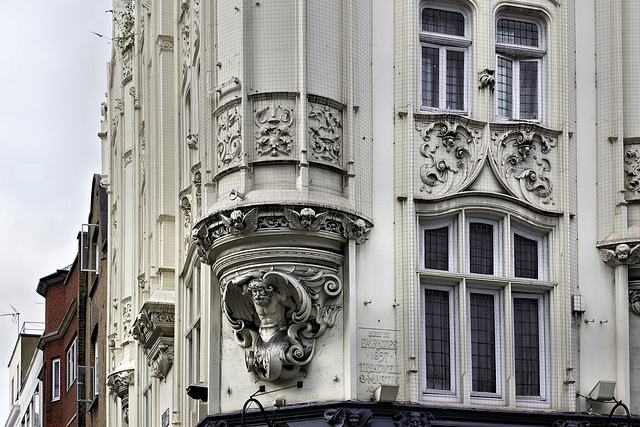Jonathan Cohen's photos
The Beaver Building – Oxford Street, Soho, London, England
The Marquis of Granby – Rathbone Street, Fitzrovia, London, England
Flights of Angels – Tottenham Court Road at Windmill Street, Fitzrovia, London, England
A Bartizan – Tottenham Court Road at Windmill Street, Fitzrovia, London, England
Art Nouveau Gothic – Tottenham Court Road at Windmill Street, Fitzrovia, London, England
The Rising Sun Public House – Tottenham Court Road at Windmill Street, Fitzrovia, London, England
This imposing four-storey structure houses the Rising Sun, a public house at 46 Tottenham Court Road, Fitzrovia, London. This pub was established in 1730 and most recently re-built in 1897 in Art Nouveau Gothic style by two much admired Victorian architects Leonard Martin (1869-1935) and Henry John Treadwell (1861-1910). The Rising Sun is said to be their masterpiece. It is an elaborate building with classical pilasters framing the second floor windows, a high parapet and a three-bayed return facade to Windmill Street. It sports delicate mouldings, heraldic beasts, rising suns, decorative gables, and an elegant bartizan. (A bartizan is an overhanging turret.)
In the early 1980’s, the owners of the day made a bizarre decision. They changed its name to The Presley, lowered the ceiling by about two yards, anointed it with pictures of Elvis and turned it into a rock 'n' roll bozo. It was an eccentric interlude which the next owners, Scottish and Newcastle, speedily put behind them. It is now The Rising Sun again, or almost. The extravagant Victorian interior is irretrievably gone. It is now what they call an Ale House: bare boards, real ales and speedy pies. The facade, though, has been meticulously restored. So good news from this generally ill-favoured thoroughfare. Outside, a minor masterpiece rescued. Inside, well, at least the ceiling is back where it belongs. It is a Grade II listed building with English Heritage.
St Marylebone Parish Church – Marylebone Road, London, England
St Marylebone Parish Church is an Anglican church on the Marylebone Road in London. It was built to the designs of Thomas Hardwick in 1813–17. The present site is the third used by the parish for its church. The first was further south, near Oxford Street. The church there was demolished in 1400 and a new one erected further north. This was completely rebuilt in 1740–42, and converted into a chapel-of-ease when Hardwick’s church was constructed.
A local resident was Charles Dickens (1812–1870), in Devonshire Terrace, whose son was baptized in this church (a ceremony fictionalized in "Dombey and Son"). Robert Browning and Elizabeth Barrett were married in this phase of the church in 1846 (their marriage certificate is preserved in the church archives). The church was also used in location filming for the 1957 film recounting their story, The Barretts of Wimpole Street.
Sherlock Holmes' Study – 221b Baker Street, Marylebone, London, England
221b Baker Street is the London address of the fictional detective Sherlock Holmes, created by author Sir Arthur Conan Doyle. When the "Sherlock Holmes" stories were first published, street numbers in Baker Street did not go as high as 221, which was presumably why Conan Doyle chose a higher street number for the location of his hero, to prevent any person’s actual residence from being affected. When street numbers were reallocated in the 1930s, the block of odd numbers from 215 to 229 was assigned to an Art Deco building known as Abbey House, constructed in 1932 for the Abbey Road Building Society, which the society and its successor (which subsequently became Abbey National plc) occupied until 2002. Almost immediately, the building society started receiving correspondence from Sherlock Holmes fans all over the world, in such volumes that it appointed a permanent "secretary to Sherlock Holmes" to deal with it.
The Red-Headed League – 221b Baker Street, Marylebone, London, England
The Sherlock Holmes Museum is situated within an 1815 townhouse very similar to the 221B described in the stories and is located between 237 and 241 Baker Street. It displays exhibits in period rooms, wax figures and Holmes memorabilia, with the famous study overlooking Baker Street the highlight of the museum.
Jump to top
- ipernity © 2007-2025
- Help & Contact
|
Club news
|
About ipernity
|
History |
ipernity Club & Prices |
Guide of good conduct
Donate | Group guidelines | Privacy policy | Terms of use | Statutes | In memoria -
Facebook
Twitter










